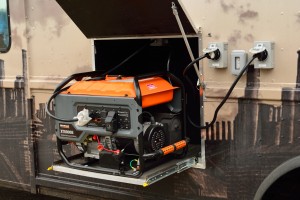 Print a Sign-In Sheet | Spanish Version
Print a Sign-In Sheet | Spanish Version
Portable generators are used when remote electricity is needed as well as during recovery efforts and cleanup from tornadoes, hurricanes, earthquakes, etc. These portable generators are internal combustion engines, and safe work practices can minimize your chances of injury.
When renting or buying a generator, select one that is rated for the power you need. To determine the necessary power, consult labels on any lighting, tools, appliances, etc., to be powered by the generator. A rule of thumb is to select a generator that will produce more power than will be used by the combined equipment, including the initial surge when the generator is turned on. A plan should be developed to stagger operating times for various pieces of equipment if the generator does not meet your power needs.
What causes injuries and fatalities?
- Shocks & electrocution.
- Carbon monoxide (CO) exposure.
- Fire hazards
- Noise and vibration hazards.
Shocks & electrocution
Generator users sometimes bypass the safety devices that are built into electrical systems. This creates additional hazards since the electricity that is generated has the same hazards as normal utility-supplied electricity.
- Do not attach generators directly into the electrical system of a structure (trailer, office, home, etc.) unless the generator has been equipped with a transfer switch, which should be installed by a qualified electrician.
- Use grounded (three-pronged) extension cords or the cords that are supplied by the manufacturer. Cords should be inspected daily for cuts, frays, or other damages. Defective cords should be discarded and never used. Also use cords that are rated for their intended use. Replace underrated cords with ones that use heavier gauge wires and are correctly rated. An overloaded generator can cause overheating and lead to a fire.
- Ground fault circuit interrupters (GFCIs) should be used where electrical equipment is being used in wet or damp areas. GFCIs cut off power when a current is found to be outside normal paths. Regardless of GFCIs, any electrical equipment should be listed and approved for damp and wet conditions.
- The generator should be properly grounded. Grounding connections should be tight. Proper grounding methods should be outlined in the manufacturer’s instruction manual.
- If a generator is going to be used in the rain, it should be protected by a canopy. The generator should be dry at all times, and its electrical components should never be manipulated if you are wet (including your hands) or standing in water.
- Electrical equipment that has been submerged in water should never be used. Dry the equipment thoroughly before use.
- If any electrical equipment begins to smoke or emit strange odors, shut the power off immediately.
Carbon monoxide exposure
Your generator must be sufficiently ventilated to prevent poisoning from CO. CO is a toxic gas that is both odorless and colorless.
- Do not use generators in enclosed spaces or indoors. These areas include crawl spaces, garages, and basements. Opening all doors and windows in these areas may not prevent CO buildup.
- To ensure sufficient ventilation the generator must have three to four feet of clear space on all sides and above it.
- If your generator is being used outdoors, do not place it near doors, windows, or vents that could allow CO to enter and build up in occupied spaces.
- If symptoms such as headaches, dizziness, nausea, and tiredness are apparent, get to fresh air immediately and seek medical attention.
Fire hazards
Generators can be used for long periods of time. This can cause the engine to be hot while running and remain hot for long periods of time after it has been shut off.
- Fuel spilled onto generators, when hot, can ignite.
- Allow the generator to cool down before refueling.
- Store and transport fuel in an approved safety container that is well vented and designed and marked for its contents.
- Keep fuel away from ignition sources and heat generating devices, such as fuel-burning appliances, lighters, matches, and the generator itself.
- Do not smoke around the generator or fuel containers.
- Vapors can travel undetected for long distances to ignition sources.
- Do not store fuel in your home.
Noise and vibration hazards
Too much noise and vibration can cause hearing loss and fatigue that can affect job performance.
- Keep generators away from high traffic and work areas as much as possible to prevent noise and vibration exposure to workers and bystanders.
- The use of hearing protection may be needed in areas where generators are utilized.
KEMI does not assume liability for the content of information contained herein. Safety and health remain your responsibility. This information is to be used for informational purposes only and not intended to be exhaustive or a substitute for proper training, supervision or manufacturers’ instructions/recommendations. KEMI, by publication of this information, does not assume liability for damage or injury arising from reliance upon it. Compliance with this information is not a guarantee or warranty that you will be in conformity with any laws or regulations nor does it ensure the absolute safety of any person, place or object, including, but not limited to, you, your occupation, employees, customers or place of business.

